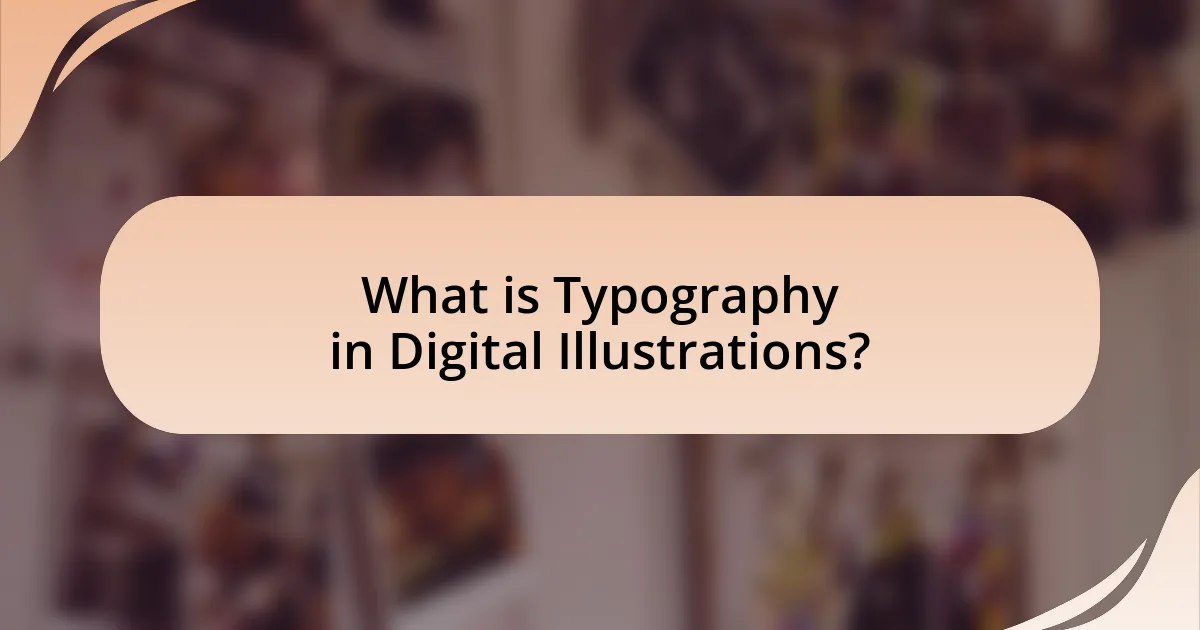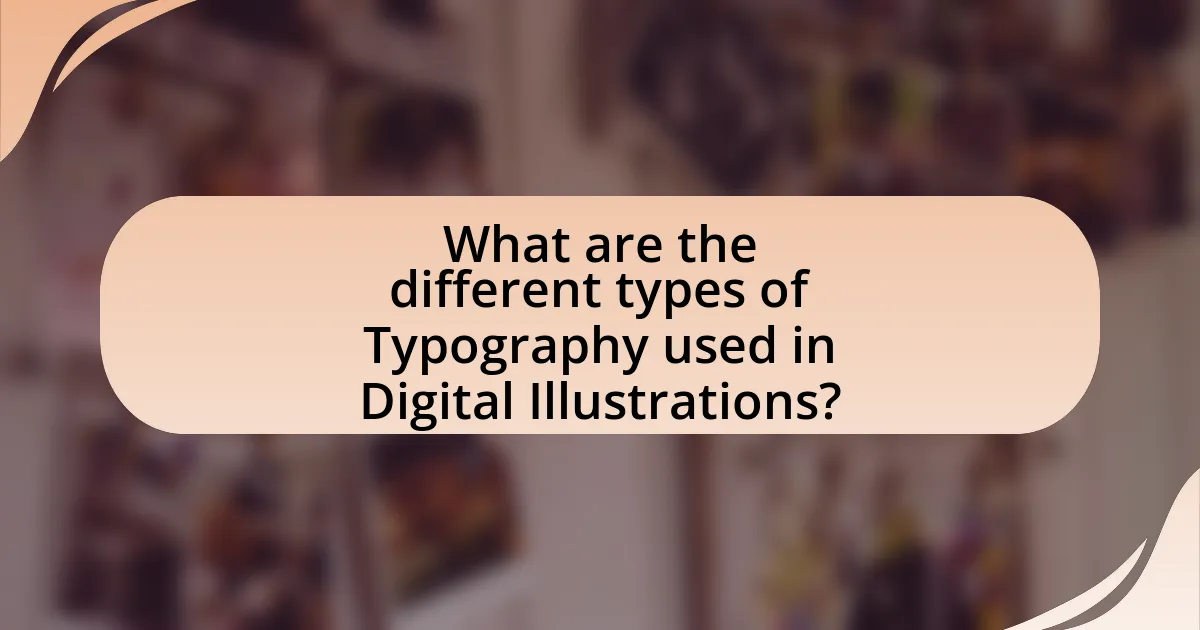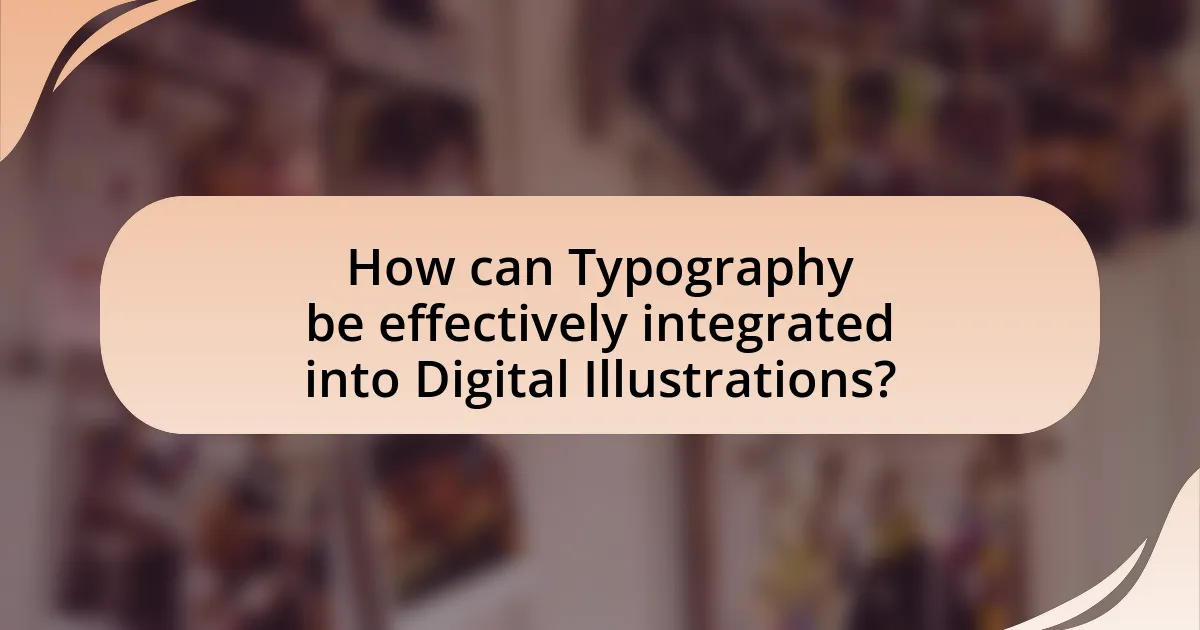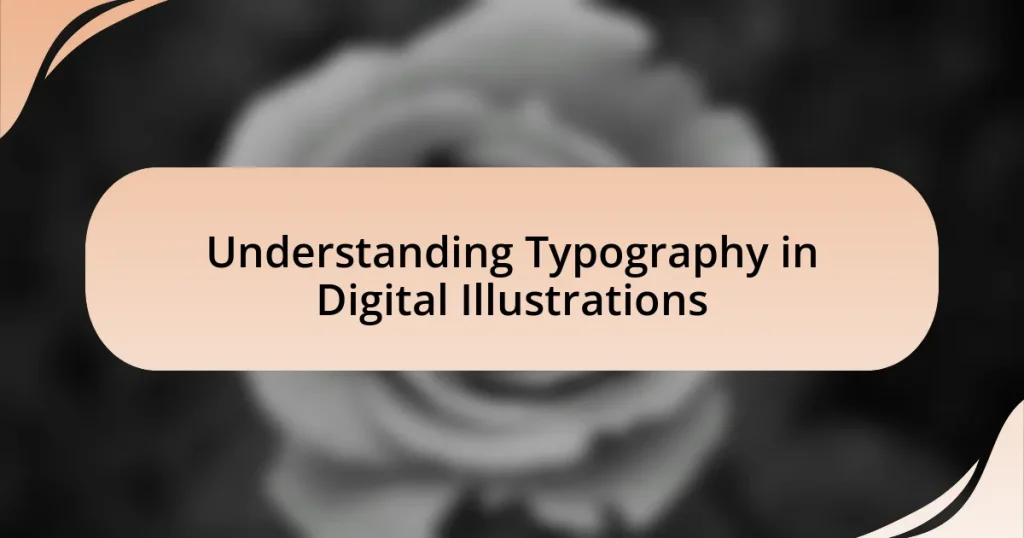Typography in digital illustrations is the art of arranging type to enhance legibility, readability, and visual appeal within digital artwork. This article explores the influence of typography on visual hierarchy, emotional impact, and user engagement, highlighting key elements such as font choice, size, spacing, alignment, and color. It discusses the different types of typography, including serif, sans-serif, script, and display fonts, and their appropriate applications. Additionally, the article outlines best practices for integrating typography with imagery, common mistakes to avoid, and resources for improving typography skills, emphasizing its critical role in effective communication and design aesthetics in digital illustrations.

What is Typography in Digital Illustrations?
Typography in digital illustrations refers to the art and technique of arranging type to make written language legible, readable, and visually appealing within digital artwork. This involves selecting fonts, sizes, spacing, and alignment to enhance the overall design and communicate the intended message effectively. The importance of typography in digital illustrations is underscored by its ability to influence viewer perception and engagement, as studies show that well-designed typography can improve readability by up to 30%.
How does Typography influence Digital Illustrations?
Typography significantly influences digital illustrations by affecting visual hierarchy, readability, and emotional impact. The choice of typeface, size, and spacing can guide the viewer’s attention and enhance the overall aesthetic of the illustration. For instance, a bold typeface can convey strength and urgency, while a script font may evoke elegance and creativity. Research indicates that typography can improve comprehension by up to 30% when appropriately matched with visual elements, demonstrating its critical role in effective communication within digital illustrations.
What are the key elements of Typography in this context?
The key elements of typography in the context of digital illustrations include font choice, size, spacing, alignment, and color. Font choice affects readability and conveys the intended tone; for instance, serif fonts often suggest tradition, while sans-serif fonts imply modernity. Size is crucial for hierarchy and emphasis, ensuring that important information stands out. Spacing, including line height and letter spacing, enhances legibility and visual appeal. Alignment organizes text within the layout, guiding the viewer’s eye, while color influences mood and can create contrast or harmony with the illustration. These elements collectively contribute to effective communication and aesthetic quality in digital illustrations.
How does Typography enhance visual communication in illustrations?
Typography enhances visual communication in illustrations by providing clarity, hierarchy, and emotional resonance. Clear typography ensures that the message is easily readable, which is essential for effective communication. Hierarchical typography guides the viewer’s attention, emphasizing key information and creating a structured flow of content. Additionally, the choice of typeface can evoke specific emotions or themes, reinforcing the overall message of the illustration. For instance, a bold sans-serif font may convey modernity and strength, while a delicate serif font might suggest tradition and elegance. This strategic use of typography in illustrations not only aids in conveying information but also enriches the viewer’s experience by aligning visual elements with textual content.
Why is Typography important in Digital Illustrations?
Typography is important in digital illustrations because it enhances visual communication and establishes a cohesive design. Effective typography guides the viewer’s attention, conveys the intended message, and influences emotional responses. Research indicates that well-chosen fonts can improve readability by up to 30%, making the content more accessible and engaging. Additionally, typography contributes to brand identity; for instance, companies like Apple and Coca-Cola use specific typefaces to reinforce their brand image. Thus, typography is a critical element that integrates text and visuals, ensuring clarity and aesthetic appeal in digital illustrations.
What role does Typography play in user engagement?
Typography significantly influences user engagement by affecting readability, emotional response, and overall aesthetic appeal. Effective typography enhances the clarity of content, making it easier for users to absorb information quickly, which is crucial in digital environments where attention spans are limited. Research indicates that well-chosen fonts can evoke specific emotions; for instance, serif fonts often convey tradition and reliability, while sans-serif fonts are perceived as modern and clean. A study by the University of Reading found that typography can impact comprehension by up to 30%, demonstrating its critical role in user interaction. Thus, the strategic use of typography not only captures attention but also fosters a deeper connection between users and content.
How can Typography affect the overall aesthetic of an illustration?
Typography significantly influences the overall aesthetic of an illustration by establishing mood, enhancing readability, and creating visual hierarchy. The choice of typeface, size, and spacing can evoke specific emotions; for instance, a serif font may convey tradition and elegance, while a sans-serif font often appears modern and clean. Additionally, typography can improve readability, ensuring that text complements the visual elements rather than detracting from them. Effective typography also establishes a visual hierarchy, guiding the viewer’s eye and emphasizing key information within the illustration. Studies in design psychology indicate that well-integrated typography can increase viewer engagement and comprehension, reinforcing the importance of thoughtful typographic choices in digital illustrations.

What are the different types of Typography used in Digital Illustrations?
The different types of typography used in digital illustrations include serif, sans-serif, script, display, and monospace fonts. Serif fonts, characterized by small lines or decorative strokes at the ends of letters, are often used for traditional and formal designs. Sans-serif fonts, which lack these embellishments, provide a clean and modern look, making them popular for digital interfaces. Script fonts mimic handwritten text and are used to convey elegance or creativity. Display fonts are designed for attention-grabbing headlines and artistic purposes, while monospace fonts, where each character occupies the same horizontal space, are commonly used in coding and technical illustrations. Each type serves distinct purposes in enhancing visual communication and user experience in digital illustrations.
How do Serif and Sans Serif fonts differ in usage?
Serif and Sans Serif fonts differ primarily in their visual characteristics and usage contexts. Serif fonts, which feature small decorative lines or “serifs” at the ends of their strokes, are often used in print media, such as books and newspapers, because they enhance readability in long texts. In contrast, Sans Serif fonts, lacking these embellishments, are commonly utilized in digital formats and on screens, as their clean lines improve legibility at various sizes and resolutions. Research indicates that users tend to prefer Sans Serif fonts for online content due to their modern appearance and clarity, making them suitable for websites and digital interfaces.
What are the advantages of using Serif fonts in illustrations?
Serif fonts offer several advantages in illustrations, primarily enhancing readability and conveying a sense of tradition and professionalism. The distinct strokes at the ends of letters in serif fonts guide the eye along lines of text, making them easier to read, especially in printed materials. Research indicates that serif fonts can improve reading speed and comprehension, particularly in longer texts, due to their familiarity and visual cues. Additionally, serif fonts often evoke a classic and authoritative feel, which can enhance the overall aesthetic of an illustration and align with themes of reliability and trustworthiness.
When is it appropriate to use Sans Serif fonts?
Sans Serif fonts are appropriate for digital illustrations when clarity and readability are essential, particularly in online content and user interfaces. These fonts lack the decorative strokes found in Serif fonts, making them easier to read on screens, especially at smaller sizes. Research indicates that Sans Serif fonts enhance legibility in digital formats, as demonstrated in studies by the International Journal of Human-Computer Interaction, which found that users preferred Sans Serif for web content due to its clean appearance and straightforward readability.
What are Display and Script fonts, and how are they applied?
Display fonts are designed for large sizes and are often used for headlines, titles, and attention-grabbing text due to their decorative and bold characteristics. Script fonts, on the other hand, mimic handwriting and are typically used for invitations, branding, and any context where a personal touch is desired. Display fonts are applied in contexts where visual impact is crucial, while script fonts are applied to convey elegance and personality in design.
What are the characteristics of Display fonts?
Display fonts are characterized by their decorative and attention-grabbing design, making them suitable for headlines and promotional materials. These fonts often feature unique shapes, exaggerated proportions, and intricate details that enhance visual impact. Unlike body text fonts, display fonts are typically used at larger sizes to maintain legibility and effectiveness, as their distinct features can become less readable at smaller sizes. The use of display fonts can evoke specific emotions or themes, aligning with branding and artistic intent, which is crucial in digital illustrations.
How can Script fonts add personality to illustrations?
Script fonts can add personality to illustrations by conveying emotions and styles that align with the visual narrative. These fonts often mimic handwriting, which can evoke a sense of warmth, creativity, and individuality, making the illustration feel more personal and relatable. For instance, a flowing script font can suggest elegance and sophistication, while a more playful script can impart a sense of fun and whimsy. Research indicates that typography significantly influences viewer perception; a study published in the journal “Design Studies” found that typefaces can affect emotional responses and brand associations, reinforcing the idea that script fonts can enhance the emotional depth of illustrations.

How can Typography be effectively integrated into Digital Illustrations?
Typography can be effectively integrated into digital illustrations by ensuring that the type complements the visual elements and enhances the overall message. This integration involves selecting appropriate fonts that align with the illustration’s theme, maintaining readability through size and spacing, and using color contrast to ensure visibility against the background. Research indicates that harmonious typography can improve user engagement and comprehension, as seen in studies where well-integrated text and visuals led to a 30% increase in information retention among viewers.
What are the best practices for combining Typography with imagery?
The best practices for combining typography with imagery include ensuring contrast, maintaining hierarchy, and aligning styles. Contrast is crucial; text should stand out against the background image to enhance readability. For instance, using light text on a dark image or vice versa can significantly improve visibility. Maintaining hierarchy involves using different font sizes and weights to guide the viewer’s attention, making the most important information prominent. Additionally, aligning the typography style with the imagery’s theme creates a cohesive visual experience; for example, a playful font may complement a whimsical image, while a serif font may suit a more formal photograph. These practices are supported by design principles that emphasize clarity and visual harmony, which are essential for effective communication in digital illustrations.
How can contrast enhance the readability of text in illustrations?
Contrast enhances the readability of text in illustrations by creating a clear distinction between the text and its background. This differentiation allows viewers to easily identify and comprehend the text, as high contrast improves legibility. For example, using dark text on a light background or vice versa can significantly increase visibility. Research indicates that optimal contrast ratios, such as a minimum of 4.5:1 for normal text, are essential for accessibility and readability, as outlined in the Web Content Accessibility Guidelines (WCAG). Thus, effective use of contrast not only aids in visual clarity but also ensures that the text is accessible to a wider audience.
What techniques can be used to maintain visual harmony?
To maintain visual harmony in typography for digital illustrations, techniques such as consistent font pairing, balanced spacing, and color harmony should be employed. Consistent font pairing involves selecting typefaces that complement each other in style and weight, ensuring a cohesive look. Balanced spacing, including line height and letter spacing, enhances readability and visual flow, preventing clutter. Color harmony can be achieved by using a limited color palette that aligns with the overall design theme, creating a unified aesthetic. These techniques are supported by design principles that emphasize the importance of coherence and balance in visual communication.
What tools and software are available for Typography in Digital Illustrations?
Adobe Illustrator is a leading software for typography in digital illustrations, offering extensive tools for creating and manipulating text. Other notable tools include Adobe InDesign, which specializes in layout design and typography, and CorelDRAW, known for its vector graphic capabilities. Additionally, software like Affinity Designer provides robust typography features, while online platforms such as Canva offer user-friendly typography options for quick designs. These tools are widely used by professionals in the graphic design industry, demonstrating their effectiveness in enhancing typography within digital illustrations.
Which design software offers the best Typography features?
Adobe Illustrator offers the best typography features among design software. It provides advanced text manipulation tools, extensive font options, and precise control over kerning, leading, and tracking. Adobe Illustrator’s integration with Adobe Fonts allows users access to thousands of typefaces, enhancing creative possibilities. Additionally, the software supports OpenType features, enabling designers to utilize ligatures, alternate characters, and stylistic sets, which are essential for professional typography work.
How can online resources assist in selecting the right fonts?
Online resources assist in selecting the right fonts by providing access to extensive font libraries, comparison tools, and user reviews. Websites like Google Fonts and Adobe Fonts offer a wide range of typefaces that can be filtered by style, usage, and popularity, enabling users to find fonts that match their specific design needs. Additionally, platforms such as FontPair and Typewolf showcase font pairings and provide visual examples, helping designers understand how different fonts work together in various contexts. These resources often include user-generated feedback and ratings, which can guide users in making informed decisions based on the experiences of others.
What are some common mistakes to avoid in Typography for Digital Illustrations?
Common mistakes to avoid in typography for digital illustrations include using too many different fonts, neglecting readability, and poor alignment. Using multiple fonts can create visual clutter and confusion, as design guidelines suggest limiting font usage to two or three to maintain coherence. Neglecting readability, especially at smaller sizes or in low-contrast situations, can hinder the viewer’s ability to engage with the content, as studies indicate that legibility significantly impacts user experience. Poor alignment disrupts the visual flow and can make the design appear unprofessional; aligning text consistently enhances organization and clarity.
How can overusing fonts detract from an illustration’s effectiveness?
Overusing fonts can detract from an illustration’s effectiveness by creating visual clutter and diminishing readability. When multiple fonts are employed, the viewer’s attention can become fragmented, making it difficult to focus on the main message. Research indicates that design principles advocate for a limited number of typefaces to maintain clarity and cohesion; for instance, the American Institute of Graphic Arts recommends using no more than two or three fonts in a single design. This limitation helps ensure that the illustration communicates its intended message clearly and effectively, rather than overwhelming the audience with competing visual elements.
What are the pitfalls of poor text placement in designs?
Poor text placement in designs can lead to decreased readability and user engagement. When text is improperly positioned, it can create visual clutter, making it difficult for viewers to focus on the content. Research indicates that 38% of users will stop engaging with a website if the content is unattractive, highlighting the importance of effective text placement. Additionally, poor alignment can disrupt the visual hierarchy, causing confusion about the message’s importance. This misplacement can also negatively impact accessibility, as users with visual impairments may struggle to read text that is not adequately contrasted or positioned. Overall, these pitfalls can significantly diminish the effectiveness of a design, leading to a loss of audience interest and comprehension.
What tips can enhance your Typography skills in Digital Illustrations?
To enhance your typography skills in digital illustrations, focus on mastering font pairing, understanding hierarchy, and practicing consistency. Mastering font pairing involves selecting complementary typefaces that work well together, which can significantly improve visual appeal. Understanding hierarchy is crucial; it helps convey the importance of information through size, weight, and placement of text, guiding the viewer’s eye effectively. Practicing consistency in style, such as maintaining uniform spacing and alignment, ensures a cohesive look across your illustrations. These techniques are supported by design principles that emphasize clarity and readability, essential for effective communication in digital media.
How can studying typography principles improve your designs?
Studying typography principles can significantly enhance your designs by improving readability, establishing hierarchy, and conveying the intended message effectively. When designers understand typography, they can select appropriate fonts, sizes, and spacing that guide the viewer’s eye and create a cohesive visual experience. Research indicates that well-chosen typography can increase comprehension by up to 30%, as it helps to organize information and draw attention to key elements. By mastering typography, designers can create more impactful and professional-looking work that resonates with their audience.
What resources are available for ongoing Typography education?
Ongoing typography education resources include online courses, workshops, books, and design communities. Platforms like Skillshare and Coursera offer structured courses on typography fundamentals and advanced techniques, while workshops from organizations like AIGA provide hands-on learning experiences. Books such as “Thinking with Type” by Ellen Lupton serve as comprehensive guides to typography principles. Additionally, design communities on platforms like Behance and Dribbble facilitate peer learning and feedback, enhancing practical skills in typography. These resources collectively support continuous learning and skill development in typography.


